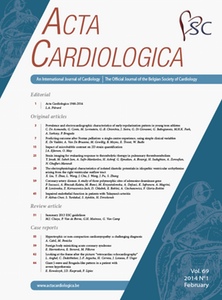 previous article in this issue previous article in this issue | next article in this issue  |

|
Document Details : Title: Diffuse coronary disease: short- and long-term outcome after percutaneous coronary intervention Author(s): G. Quadri , F. D’Ascenzo , M. Bollati , C. Moretti , P. Omedè , F. Sciuto , A. Gonella , A. Pullara , G. Longo , E. Cerrato , F. Colombo , D.G. Presutti , C. Colaci , V. De Simone , M. Di Cuia , F. Giusto , C. Reitano , G. Biondi Zoccai , I. Sheiban , F. Gaita Journal: Acta Cardiologica Volume: 68 Issue: 2 Date: 2013 Pages: 151-160 DOI: 10.2143/AC.68.2.2967272 Abstract : Aim: The aim of this study was to evaluate short- and long-term results of PCI (percutaneous coronary intervention) in patients with small vessel coronary artery disease and the prognostic impact of the extension and the length of coronary lesions. Methods and results: All consecutive patients treated with PCI in our centre between July 2002 and December 2004 were included and divided into two groups according to the diameter of the implanted stents: small vessel disease was defined as requiring implantation of stents ≤ 2.75 mm in diameter. The primary end point was the long-term incidence of major adverse cardiac events (MACE), the composite of cardiac mortality, nonfatal myocardial reinfarction, and repeated percutaneous target vessel revascularization (re-PTCA TVR). 1599 patients were treated by PCI: 419 (26.2%) were implanted with 2.75 mm or smaller stents. At both 1 and 36 months as well as at 53 ± 20 months of follow-up small vessel stenting was associated with a higher rate of MACE (4.2% vs 2.1%, P = 0.028; 20.3% vs 17.9%, P < 0.001; 27.5% vs 22.4%, P = 0.04, respectively). Multivariate analysis showed higher rates of revascularization for patients with small vessel disease regardless of lesion length. Rates of death were higher in patients with small vessels and long lesions. Conclusion: Atherosclerotic involvement of small vessels in patients with CAD confers a higher short- and long-term risk of adverse outcome after PCI. |
